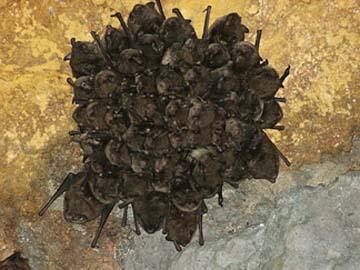GR: Energy production destroys wildlife. Burning fossil fuel is has the worst impact, but wind and solar are also harmful. Unless we reverse our population growth, cut our resource use, and reduce our energy needs, we will continue to drive our fellow species toward extinction.
Small hibernating bat colonies need protection
to prevent extinction
 “Between collisions with wind turbines and deadly white-nose syndrome, endangered Indiana bats may not have much of a chance of recovering, according to a recently published U.S. Geological Survey study.
“Between collisions with wind turbines and deadly white-nose syndrome, endangered Indiana bats may not have much of a chance of recovering, according to a recently published U.S. Geological Survey study.
“The researchers used a scientific model to compare how wind turbine mortality and WNS may singly and then together affect Indiana bat population dynamics throughout the species’ U.S. range.
“Bats are valuable because, by eating insects, they save U.S. agriculture billions of dollars per year in pest control,” said USGS scientist Richard Erickson, the lead author of the study. “Our research is important for understanding the threats to endangered Indiana bats and can help inform conservation efforts.”
“Wind energy generation can cause bat mortality when certain species, including the midwestern Indiana bat, approach turbines during migration. Meanwhile, WNS, which is caused by the Pseudogymnoascus destructans fungus, has killed millions of hibernating bats in North America and is spreading. The new study found that the combination of these two hazards has a larger negative impact on Indiana bats than either threat alone.” –Bob Berwin (Continue reading: Endangered Indiana bats face twin threat from wind turbines and white-nose syndrome – Summit County Citizens Voice.)

